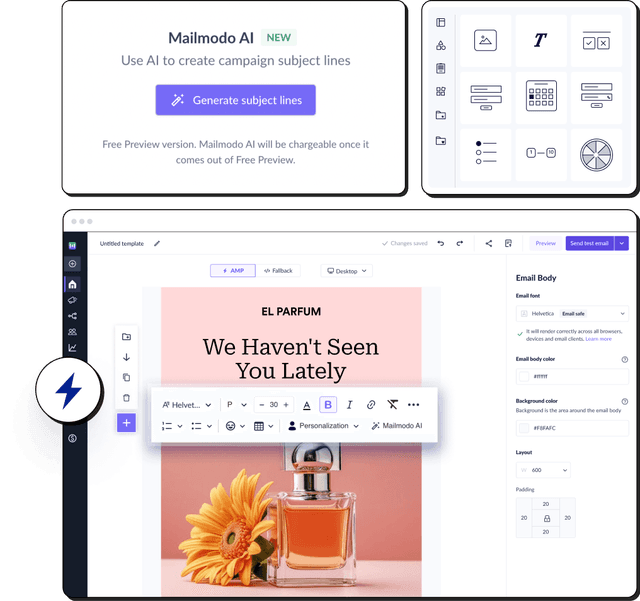5 types of email closings that work
We present before you five ways to end an email that works in the majority of professional situations today.
The one with gratitude
We all love it when someone expresses gratitude towards us. It makes us feel valuable, and it puts our hard work to rest. It also creates a kind of positive impression.
While all this is true, there are times when the idea of saying thank you in advance before the actual work is done may sound a bit pushy. To avoid situations like these, use the closings given below:
1. Thank you for guiding me in the right direction: This email sign-off is a great way to end an email when someone has assisted effectively or when you want to indirectly tell them that you may need their assistance next time as well.
2. Thanks for your consideration: When someone has invested their time, energy, or emotions or just gone out of their way to make you feel comfortable, this email sign-off can do wonders for you in establishing a positive relationship. It is a sign that you are a courteous person, and their efforts have not gone unnoticed.
3. I appreciate your help in this matter: Similar to the previous one, the only difference is that this is more personalized.
4. Thanks, and let me know if there are any issues: This sets a friendly tone and shows that you are not only grateful but are ready to walk that extra mile to help your colleague, friend, or team member.
5. Excellent working with you or lovely speaking to you: Sentences like these are why relationships in the corporate world are intact. Expressions like these in business emails are a good idea to ensure that your friends, colleagues, and team members look forward to working with you.
6. Thanks in advance for your cooperation: It is probably best avoided unless you are reasonably sure that the answer will be positive.
7. With gratitude: This email closing is a simple yet polite way to express your thanks and appreciation.
The one with casual sign-offs
You can use this email ending in casual emails with your very close friends, team members, and colleagues with whom you share a close relationship and great rapport to add a personal touch.
8. Cheers: Yes, we are not at a party, but if you share high energy with your tribe, Cheers is the way to go. It is used across different cultures.
9. Later: A casual email sign-off, best used on someone you already know. Otherwise, you risk being misinterpreted by some.
10. Thanks: When you want to wrap up something and request things from the recipient, this is the best way to end the conversation.
11. Happy weekday: A friendly way to end your email that sounds very genuine and sweet.
12. Have a wonderful weekend: Try this, the concerned person will remember you for life. It is just the perfect way to cheer anyone up.
13. Warmly: A sign-off you can use if your email doesn’t have an overly professional tone.
14. Drop me a line if you have any questions: This casual conversation sets a positive tone and shows that you are very approachable and always ready to help.
15. See you around: This is an email closing to let the other person know that you are willing to catch up with them for work or personal purposes in the future. For example, it’s best to make a polite exit when another person participates in a new project.
16. Sending you good vibes: An encouraging email to show your colleagues that you are on the positive side. It can motivate your colleagues to a great extent.
17. Go (prospect's favorite sports team): If you know that your friend is a fan of a particular group, show them that you are also rooting for the same team, and this will also give them a sense of belongingness.
The one with professional email sign-offs
You can use this formal closing to develop healthier business relationships in your professional world. A few of the safest professional ways to end formal emails are as follows:
18. Best: This is today's most globally used email sign-off.
19. Best regards: The same as the previous one, but it sounds a bit more professional.
20. Kind regards: Kind regards is a more formal variation of best regards.
21. Warm regards: An ending that can never go wrong.
22. Sincerely: A bit old-fashioned but still professional sign-off.
23. Thank you: The same as “thanks” but more appropriate in a professional setting.
24. Respectfully: This is a safe bet while addressing your seniors.
25. As ever: This is an excellent example of email closing to use with people you have built good working relationships with, and it reassures your network that all is good between you two.
The one with collaborative sign-offs
Try out these email closings for better click rates and chances of a response:
26. Hoping for a spot in your calendar: Use this email sign-off when you want the person you are interacting with to spare some time for you to discuss something significant.
27. Eager to continue our collaboration: Use this email ending when you look forward to working with a particular team or a person. You have worked with them previously, and this time it is a new project.
28. Hope to speak to you soon: Use this email sign-off when you are constantly in touch with this person via phone number or Skype and eagerly looking forward to confirming the next meeting.
29. Excited to be working with you on [project]: Use this email when you are very serious about working with a particular team or individual and expect the same kind of understanding and participation.
The one when responding to a rejection email
When you receive a rejection email, it can be disappointing, but maintaining professionalism is crucial. Your sign-off should convey politeness, leave a positive impression, and keep the door open for future opportunities. Here are some effective options:
30. Thank you once again for considering me: This shows you’re not upset and that you respect their decision, despite the unfavorable outcome.
31. I appreciate your time: This indicates that you recognize they took the time to evaluate your offer/application/suggestion thoughtfully.
32. I’m grateful for your feedback: This is a straightforward and neutral way to express thanks for the opportunity you were given.
33. If things change, please let me know: Ending with this phrase shows your desire to maintain contact and possibly revisit the conversation later.
Email closings to avoid
Some of the email closings that you should avoid are:
1. Anything with "yours"
An email signature that starts with "Yours"; be it "Yours indeed", "Yours sincerely", or "Yours faithfully" sets the email's tone to be fake or sound like a marriage proposal, or is just plain and abrupt.
2. Abbreviations
When someone takes time out to read an email, we must respect that. It does not take much effort to write “thanks” instead of“ thnx” If you are not bothered to write a few extra lines, why would anybody be bothered to read the content in the email?
💡 Related guide: 30 Most Commonly Used Email Abbreviations and Acronyms
3. Anything that can feel passive-aggressive
Sign-offs such as “Looking forward to hearing from you” can come across as very demanding and passive-aggressive and can put you in a waiting position, unable to act until you have heard from them.
The problem with “I look forward to hearing from you" is that it removes you from the active role and puts you in a subservient position.
Now all you are doing is waiting passively for the response rather than moving the email forward, and your recipient may not even know what you want from them.
4. Saying nothing
A lot of people consider the worst sign-off as none at all. It may work with a colleague you send dozens of messages to every day, but it’s best to make a polite exit consequently, even if you know the recipient very well.
Best practices for email closings
The best practices of email closing will guide you in challenging situations. Please continue reading for a better understanding of effective email closing.
Provide personal information: Never forget to include your professional email signature at the end of your email. It typically includes your full name, company logo, job title, relevant social media links, and additional contact information.
Recollect your relationship and write accordingly: If it is a casual exchange, end the email in a warm tone. If it is professional communication in a serious business setting end your email accordingly.
Check for spelling: You need to be careful about spelling or typos while writing an email. Any spelling mistake from your side might create an impression of you being casual or inattentive. Always write a follow-up email to correct your error and maintain a good impression on your network.
Do not overdo it: Is it essential to add additional information like your Facebook or Instagram account or LinkedIn profile while emailing? Is the size of your logo too big or distracting? Please check such minute details while sending an email. Make sure your email does not appear too flashy or distracting.
Use different sign-offs: Use your creativity to customize your email -sign off and keep changing it from time to time to keep the spark alive.
Make it personal: Let the email recipient know how much you love a particular color or template. Also, try and personalize your email closing, which will help them recall your message and build stronger relationships.
Add a call to action: Adding a call to action in your email will keep the email reader engaged and help them remember the email’s agenda.
Make use of A/B testing: With A/B testing, you can try sending one variation of email closing to one group of email recipients and another variation to another group. And then, see which got the most clicks and use that closing in the future.









